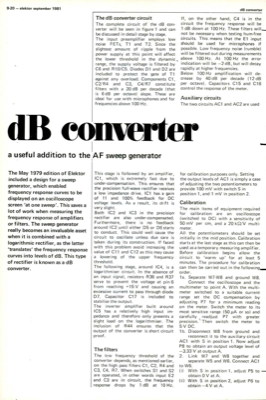Article
dB converter

9-20 — elektor september 1981 dB converter The dB converter circuit The complete circuit of the dB con- verter will be seen in figure 1 and can be discussed in detail stage by stage. The input preamplifier employs low noise FETs, T1 and T2. Since the slightest amount of ripple from the power supply at this point will affect the lower threshold in the dynamic range, the supply voltage is filtered by C6 and R10/C5. Diodes D1 and D2 are included to protect the gate of T1 against any overload. Components C1, C2/R4 and C3, C4/R7 constitute filters with a 20 dB per decade (that is 6 dB per octave) slope. These are ideal for use with microphones and for frequencies above 100 Hz. If, on the other hand, C4 is in the circuit the frequency response will be 1 dB down at 100 Hz. These filters will._ not be necessary when testing hum-free circuits. This means that the El input should be used for microphones if possible. Low frequency noise (rumble) will be filtered out during measurements abo...


Discussion (0 comments)